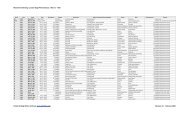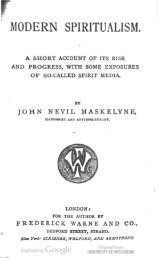- Page 1:
ryftv % »--■■■, ■■£■
- Page 4 and 5:
VVPA 1853 Entered, according to Act
- Page 6 and 7:
iv CONTENTS. ghap. xxv. diseases of
- Page 8 and 9:
6 ESOTERIC ANTHROPOLOGY. « subject
- Page 10 and 11:
^ 8 ESOTERIC ANTHROPOLOGY. valion,
- Page 12 and 13:
1Q ESOTERIC ANTHROPOLOGY. CHAPTER I
- Page 14 and 15:
12 ESOTERIC ANTHROPOLOGY. they are
- Page 16 and 17:
14 ESOTERIC ANTHROPOLOGY. The whole
- Page 18 and 19:
16 ESOTERIC ANTHROPOLOGY. intellect
- Page 20 and 21: 18 ESOTERIC ANTHROPOLOGY. CHAPTER I
- Page 22 and 23: 20 ESOTERIC ANTHROPOLOGY. ' perform
- Page 24 and 25: 22 ESOTERiJ ANTHROPOLOGY. immovably
- Page 26 and 27: 24 ESOTERIC ANTHROPOLOGY. wedge-lik
- Page 28 and 29: 36 The rolling ESOTERIC ANTHROPOLOG
- Page 30 and 31: 28 ESOTERIC ANTHROPOLOGY. for the t
- Page 32 and 33: 30 ESOTERIC ANTHROPOLOGY. OF THE BL
- Page 34 and 35: 32 ESOTERIC ANTHROPOLOGY. on over t
- Page 36 and 37: 34 ESOTERIC ANTHROPOLOGY. not direc
- Page 38 and 39: 36 ESOTERIC ANTHROPOLOGY. teals, an
- Page 40 and 41: 38 ESOTERIC ANTHROPOLOGY. sities or
- Page 42 and 43: 40 ESOTERIC ANTHROPOLOGY. under the
- Page 44 and 45: 42 ESOTERIC ANTHROPOLOGY. it always
- Page 46 and 47: 44 ESOTERIC ANTHROPOLOGY. of the ri
- Page 48 and 49: 46 ESOTERIC ANTHROPOLOGY. are two.
- Page 50 and 51: 48 ESOTERIC ANTHROPOLOGY. set, and
- Page 52 and 53: 50 ESOTERIC ANTHROPOLOGY. of severa
- Page 54 and 55: 52 ESOTERIC ANTHROPOLOGY. change ha
- Page 56 and 57: 54 ESOTERIC ANTHROPOLOGY. VISCERA O
- Page 58 and 59: ESOTERIC ANTHROPOLOGY. Fig. 26. EXT
- Page 60 and 61: 58 ESOTERIC ANTHROPOLOGY. parts of
- Page 62 and 63: 60 ESOTERIC ANTHROPOLOGY. CHAPTER I
- Page 64 and 65: 62 ESOTERIC ANTHROPOLOGY. measure,
- Page 66 and 67: 64 ESOTERIC ANTHROPOLOGY. 3. Two or
- Page 68 and 69: 66 ESOTERIC ANTHROPOLOGY. The three
- Page 72 and 73: 70 ESOTERIC ANTHROPOLOGY. CHAPTER V
- Page 74 and 75: 72 ESOTERIC ANTHROPOLOGY. soul meas
- Page 76 and 77: 74 ESOTERIC ANTHROPOLOOY. in which
- Page 78 and 79: 76 ESOTERIC ANTHROPOLOGY. the race
- Page 80 and 81: 78 ESOTERIC ANTHROPOLOGY. together,
- Page 82 and 83: 80 ESOTERIC ANTHROPOLOGY. which nou
- Page 84 and 85: 82 ESOTERIC ANTHROPOLOGY. the sense
- Page 86 and 87: 84 ESOTERIC ANTHROPOLOGY. of passio
- Page 88 and 89: 86 ESOTERIC ANTHROPOLOGY. CHAPTER V
- Page 90 and 91: 88 ESOTERIC ANTHROPOLOGY. estimated
- Page 92 and 93: 90 ESOTERIC ANTHROPOLOGY. than othe
- Page 94 and 95: \ 92 ESOTERIC ANTHROPOLOGY. vast am
- Page 96 and 97: 94 ESOTERIC ANTHROPOLOGY. tion. It
- Page 98 and 99: 96 ESOTERIC ANTHROPOLOGY. when it i
- Page 100 and 101: 98 ESOTERIC ANTHROPOLOGY. I power.
- Page 102 and 103: 100 ESOTERIC ANTHROPOLOGY. through
- Page 104 and 105: 102 ESOTERIC ANTHROPOLOGY. stroyed
- Page 106 and 107: 104 ESOTERIC ANTHROPOLOGY. perform
- Page 108 and 109: 106 ESOTERIC ANTHROPOLOGY. he comes
- Page 110 and 111: 108 ESOTERIC ANTHROPOLOGY. and vagu
- Page 112 and 113: 110 ESOTERIC ANTHROPOLOGY. simple a
- Page 114 and 115: 112 ESOTERIC ANTHROPOLOGY. the feel
- Page 116 and 117: 114 ESOTERIC ANTHROPOLOGY. the nerv
- Page 118 and 119: 116 ESOTERIC ANTHROPOLOGY. ments ar
- Page 120 and 121:
118 ESOTERIC ANTHROPOLOGY. common s
- Page 122 and 123:
v 120 ESOTERIC ANTHROPOLOGY. facult
- Page 124 and 125:
122 ESOTERIC ANTHROPOLOGY. show, ha
- Page 126 and 127:
124 ESOTERIC ANTHROPOLOGY. cord is
- Page 128 and 129:
126 ESOTERIC ANTHROPOLOGY. ties of
- Page 130 and 131:
128 ESOTERIC ANTHROPOLOGY. topics w
- Page 132 and 133:
130 ESOTERIC ANTHROPOLOGY. there wi
- Page 134 and 135:
132 ESOTERIC ANTHROPOLOGY. constitu
- Page 136 and 137:
134 ESOTERIC ANTHROPOLOGY. Fortunat
- Page 138 and 139:
136 ESOTERIC ANTHROPOLOGY. of the g
- Page 140 and 141:
138 ESOTERIC ANTHROPOLOGY. less deg
- Page 142 and 143:
140 ESOTERIC ANTHROPOLOGY. ing the
- Page 144 and 145:
142 ESOTERIC ANTHROPOLOGY. — sex
- Page 146 and 147:
144 ESOTERIC ANTHROPOLOGY. custom o
- Page 148 and 149:
146 ESOTERIC ANTHROPOLOGY. certainl
- Page 150 and 151:
148 ESOTERIC ANTHROPOLOGY. organ wi
- Page 152 and 153:
150 ESOTERIC ANTHROPOLOGY. forward,
- Page 154 and 155:
152 ESOTERIC ANTHROPOLOGY. sexual u
- Page 156 and 157:
154 ESOTERIC ANTHROPOLOGY. But the
- Page 158 and 159:
156 ESOTERIC ANTHROPOLOGY. happen p
- Page 160 and 161:
158 ESOTERIC ANTHROPOLOGY. It is no
- Page 162 and 163:
160 ESOTERIC ANTHROPOLOGY. Fig. 48.
- Page 164 and 165:
162 ESOTERIC ANTHROPOLOGY Fig. 45.
- Page 166 and 167:
164 ESOTERIC ANTHROPOLOGY. tial par
- Page 168 and 169:
166 ESOTERIC ANTHROPOLOGY. pended o
- Page 170 and 171:
168 ESOTERIC ANTHROPOLOGY. takes pl
- Page 172 and 173:
170 ESOTERIC ANTHROPOLOGY. The read
- Page 174 and 175:
172 ESOTERIC ANTHROPOLOGY. passion.
- Page 176 and 177:
174 ESOTERIC ANTHROPOLOGY. A piece
- Page 178 and 179:
176 ESOTERIC ANTHROPOLOGY. journey
- Page 180 and 181:
178 ESOTERIC ANTHROPOLOGY, Fig. 5T.
- Page 182 and 183:
180 ESOTERIC ANTHROPOLOGY. nous beg
- Page 184 and 185:
182 ESOTERIC ANTHROPOLOGY. very pro
- Page 186 and 187:
184 ESOTERIC ANTHROPOLOGY. At sev,e
- Page 188 and 189:
186 ESOTERIC ANTHROPOLOGY. these ve
- Page 190 and 191:
188 ESOTERIC ANTHROPOLOGY. sons, to
- Page 192 and 193:
190 ESOTERIC ANTHROPOLOGY. At a cer
- Page 194 and 195:
192 ESOTERIC ANTHROPOLOGY. dren. Wo
- Page 196 and 197:
194 ESOTERIC ANTHROPOLOGY. An impre
- Page 198 and 199:
19G ESOTERIC ANTHROPOLOGY. a physio
- Page 200 and 201:
198 ESOTERIC ANTHROPOLOGY. and duri
- Page 202 and 203:
200 ESOTERIC ANTHROPOLOGY. victims
- Page 204 and 205:
202 ESOTERIC ANTHROPOLOGY. Filthy a
- Page 206 and 207:
204 ESOTERIC ANTHROPOLOGY. had a th
- Page 208 and 209:
206 ESOTERIC ANTHROPOLOGY. months f
- Page 210 and 211:
208 ESOTERIC ANTHROPOLOGY. feet lov
- Page 212 and 213:
210 ESOTERIC ANTHROPOLOGY. conseque
- Page 214 and 215:
212 ESOTERIC ANTHROPOLOGY. her sexu
- Page 216 and 217:
214 ESOTERIC ANTHROPOLOGY. have no
- Page 218 and 219:
216 ESOTERIC ANTHROPOLOGY. trial as
- Page 220 and 221:
218 ESOTERIC ANTHROPOLOGY. It is th
- Page 222 and 223:
220 ESOTERIC ANTHROPOLOGY. tion of
- Page 224 and 225:
222 ESOTERIC ANTHROPOLOGY. CONTINUA
- Page 226 and 227:
224 ESOTERIC ANTHROPOLOGY. individu
- Page 228 and 229:
226 ESOTERIC ANTHROPOLOGY. It is a
- Page 230 and 231:
228 ESOTERIC ANTHROPOLOGY. fullness
- Page 232 and 233:
230 ESOTERIC ANTHROPOLOGY. integrit
- Page 234 and 235:
232 ESOTERIC ANTHROPOLOGY. These co
- Page 236 and 237:
234 ESOTERIC ANTHROPOLOGY. and tend
- Page 238 and 239:
236 ESOTERIC ANTHROPOLOGY. masters'
- Page 240 and 241:
238 ESOTERIC ANTHROPOLOGY. the vice
- Page 242 and 243:
240 ESOTERIC ANTHROPOLOGY. greater
- Page 244 and 245:
242 ESOTERIC ANTHROPOLOGY. five org
- Page 246 and 247:
244 ESOTERIC ANTHROPOLOGY. If a man
- Page 248 and 249:
246 ESOTERIC ANTHROPOLOGY. Fruit an
- Page 250 and 251:
248 ESOTERIC ANTHROPOLOGY. The rule
- Page 252 and 253:
250 ESOTERIC ANTHROPOLOGY. given to
- Page 254 and 255:
252 ESOTERIC ANTHROPOLOGY. creased
- Page 256 and 257:
254 ESOTERIC ANTHROPOLOGY. benevole
- Page 258 and 259:
256 ESOTERIC ANTHROPOLOGY. loves. E
- Page 260 and 261:
258 ESOTERIC ANTHROPOLOGY. Many con
- Page 262 and 263:
260 ESOTERIC ANTHROPOLOGY. repose.
- Page 264 and 265:
262 ESOTERIC ANTHROPOLOGY. CHAPTER
- Page 266 and 267:
264 ESOTERIC ANTHROPOLOGY. it is no
- Page 268 and 269:
266 ESOTERIC ANTHROPOLOGY. lignant.
- Page 270 and 271:
268 ESOTERIC ANTHROPOLOGY. ter, mad
- Page 272 and 273:
270 ESOTERIC ANTHROPOLOGY. in the s
- Page 274 and 275:
272 ESOTERIC ANTHROPOLOGY. death, b
- Page 276 and 277:
274 ESOTERIC ANTHROPOLOGY. upon the
- Page 278 and 279:
' 276 ESOTERIC ANTHROPOLOGY. Diseas
- Page 280 and 281:
278 ESOTERIC ANTHROPOLOGY. action a
- Page 282 and 283:
280 ESOTERIC ANTHROPOLOGY. In a cro
- Page 284 and 285:
282 ESOTERIC ANTHROPOLOGY. single n
- Page 286 and 287:
284 ESOTERIC ANTHROPOLOGY. medicine
- Page 288 and 289:
286 ESOTERIC ANTHROPOLOGY. The quac
- Page 290 and 291:
288 ESOTERIC ANTHROPOLOGY. cases in
- Page 292 and 293:
290 ESOTERIC ANTHROPOLOGY. and even
- Page 294 and 295:
292 ESOTERIC ANTHROPOLOGY. vital or
- Page 296 and 297:
294 ESOTERIC ANTHROPOLOGY. sinks, n
- Page 298 and 299:
296 ESOTERIC ANTHROPOLOGY. to remov
- Page 300 and 301:
298 ESOTERIC ANTHROPOLOGY. live on
- Page 302 and 303:
300 ESOTERIC ANTHROPOLOGY. three pi
- Page 304 and 305:
302 ESOTERIC ANTHROPOLOGY. in the p
- Page 306 and 307:
304 ESOTERIC ANTHROPOLOGY. quicker
- Page 308 and 309:
306 ESOTERIC ANTHROPOLOGY. a thorou
- Page 310 and 311:
308 ESOTERIC ANTHROPOLOGY. mid-fore
- Page 312 and 313:
310 ESOTERIC ANTHROPOLOGY. quantity
- Page 314 and 315:
312 ESOTERIC ANTHROPOLOGY. haustion
- Page 316 and 317:
314 ESOTERIC ANTHROPOLOGY. kind of
- Page 318 and 319:
316 ESOTERIC ANTHROPOLOGY. cure eve
- Page 320 and 321:
318 ESOTERIC ANTHROPOLOGY. repulsiv
- Page 322 and 323:
320 ESOTERIC ANTHROPOLOGY. we act c
- Page 324 and 325:
322 ESOTERIC ANTHROPOLOGY. this is
- Page 326 and 327:
324 ESOTERIC ANTHROPOLOGY. must go
- Page 328 and 329:
326 ESOTERIC ANTHROPOLOGY. the gene
- Page 330 and 331:
328 ESOTERIC ANTHROPOLOGY. dangerou
- Page 332 and 333:
330 ESOTERIC ANTHROPOLOGY. passion,
- Page 334 and 335:
332 ESOTERIC ANTHROPOLOGY. state of
- Page 336 and 337:
334 ESOTERIC ANTHROPOLOGY. How shal
- Page 338 and 339:
336 ESOTERIC ANTHROPOLOGY. infancy,
- Page 340 and 341:
338 ESOTERIC ANTHROPOLOGY. chiefly
- Page 342 and 343:
340 ESOTERIC ANTHROPOLOGY. malaria
- Page 344 and 345:
342 ESOTERIC ANTHROPOLOGY. guide an
- Page 346 and 347:
344 ESOTERIC ANTHROPOLOGY. sary to
- Page 348 and 349:
346 ESOTERIC ANTHROPOLOGY. Where th
- Page 350 and 351:
348 ESOTERIC ANTHROPOLOGY. weak spi
- Page 352 and 353:
350 ESOTERIC ANTHROPOLOGY. Take a f
- Page 354 and 355:
352 ESOTERIC ANTHROPOLOGY. Inflamma
- Page 356 and 357:
354 ESOTERIC ANTHROPOLOGY. The firs
- Page 358 and 359:
356 ESOTERIC ANTHROPOLOGY. absolute
- Page 360 and 361:
358 ESOTERIC ANTHROPOLOGY. are the
- Page 362 and 363:
360 ESOTERIC ANTHROPOLOGY. is a par
- Page 364 and 365:
362 ESOTERIC ANTHROPOLOGY. Chronic
- Page 366 and 367:
364 ESOTERIC ANTHROPOLOGY. utes, wi
- Page 368 and 369:
366 ESOTERIC ANTHROPOLOGY. lous sub
- Page 370 and 371:
368 ESOTERIC ANTHROPOLOGY. in effus
- Page 372 and 373:
370 ESOTERIC ANTHROPOLOGY. In all c
- Page 374 and 375:
372 ESOTERIC ANTHROPOLOGY. toration
- Page 376 and 377:
374 ESOTERIC ANTHROPOLOGY. Can cons
- Page 378 and 379:
376 ESOTERIC ANTHROPOLOGY. The wet
- Page 380 and 381:
378 ESOTERIC ANTHROPOLOGY. weight o
- Page 382 and 383:
380 ESOTERIC ANTHROPOLOGY. Any kind
- Page 384 and 385:
382 ESOTERIC ANTHROPOLOGY. But how?
- Page 386 and 387:
384 ESOTERIC ANTHROPOLOGY. faithful
- Page 388 and 389:
386 ESOTERIC ANTHROPOLOGY. heroic.
- Page 390 and 391:
388 ESOTERIC ANTHROPOLOGY. Fold a s
- Page 392 and 393:
390 ESOTERIC ANTHROPOLOGY. cooling
- Page 394 and 395:
392 ESOTERIC ANTHROPOLOGY. We promo
- Page 396 and 397:
394 ESOTERIC ANTHROPOLOGY. Over the
- Page 398 and 399:
396 ESOTERIC ANTHROPOLOGY. Every fu
- Page 400 and 401:
398 ESOTERIC ANTHROPOLOGY. rative o
- Page 402 and 403:
400 ESOTERIC ANTHROPOLOGY. most pro
- Page 404 and 405:
402 ESOTERIC ANTHROPOLOGY. once the
- Page 406 and 407:
404 ESOTERIC ANTHROPOLOGY. Bathing,
- Page 408 and 409:
406 ESOTERIC ANTHROPOLOGY. Society,
- Page 410 and 411:
„ plainly 408 ESOTERIC ANTHROPOLO
- Page 412 and 413:
410 ESOTERIC ANTHROPOLOGY. lose the
- Page 414 and 415:
412 ESOTERIC ANTHROPOLOGY. the grow
- Page 416 and 417:
414 ESOTERIC ANTHROPOLOGY. continue
- Page 418 and 419:
416 ESOTERIC ANTHROPOLOGY. 1 know t
- Page 420 and 421:
418 ESOTERIC ANTHROPOLOGY. of very
- Page 422 and 423:
420 ESOTERIC ANTHROPOLOGY. There is
- Page 424 and 425:
422 ESOTERIC ANTHROPOLOGY. daughter
- Page 426 and 427:
124 ESOTERIC ANTHROPOLOGY. Retentio
- Page 428 and 429:
426 ESOTERIC ANTHROPOLOGY. own pass
- Page 430 and 431:
428 FPOTERTC ANTHROPOLOGY. until it
- Page 432 and 433:
\ 430 ESOTERIC ANTHROPOLOGY. Ulcera
- Page 434 and 435:
432 ESOTERIC ANTHROPOLOGY. Wherever
- Page 436 and 437:
434 ESOTERIC ANTHROPOLOGY. life is
- Page 438 and 439:
436 ESOTERIC ANTHROPOLOGY. how rare
- Page 440 and 441:
438 ESOTERIC ANTHROPOLOGY. work, Na
- Page 442 and 443:
440 ESOTERIC ANTHROPOLOGY. when it
- Page 444 and 445:
442 ESOTERIC ANTHROPOLOGY. untary,
- Page 446 and 447:
444 ESOTERIC ANTHROPOLOGY. her back
- Page 448 and 449:
446 ESOTERIC ANTHROPOLOGY. and the
- Page 450 and 451:
443 ESOTERIC ANTHROPOLOGY. off the
- Page 452 and 453:
450 ESOTERIC ANTHROPOLOGY. In all o
- Page 454 and 455:
452 ESOTERIC ANTHROPOLOGY. full of
- Page 456 and 457:
454 ESOTERIC ANTHROPOLOGY. A babe w
- Page 458 and 459:
456 ESOTERIC ANTHROPOLGY. two hours
- Page 460 and 461:
458 ESOTERIC ANTHROPOLOGY. society,
- Page 462 and 463:
460 ESOTERIC ANTHROPOLOGY. and sens
- Page 464 and 465:
462 ESOTERIC ANTHROPOLOGY. " I real
- Page 466 and 467:
464 ESOTERIC ANTHROPOLOGY. Even wit
- Page 468 and 469:
466 ESOTERIC ANTHROPOLOGY. CHAPTER
- Page 470 and 471:
468 ESOTERIC ANTHROPOLOGY. capillar
- Page 472 and 473:
470 ESOTERIC ANTHROPOLOGY. THE PORT
- Page 474 and 475:
472 ESOTERIC ANTHROPOLOGY. observat
- Page 476 and 477:
474 ESOTERIC ANTHROPOLOGY. meat was
- Page 478 and 479:
476 ESOTERIC ANTHROPOLOGY. plying t
- Page 480 and 481:
478 ESOTERIC ANTHROPOLOGY. likely i
- Page 482 and 483:
480 INDEXi Page Delirium Tremens 85
- Page 484:
482 INDEX. Scarlatina 345 Scrofula









